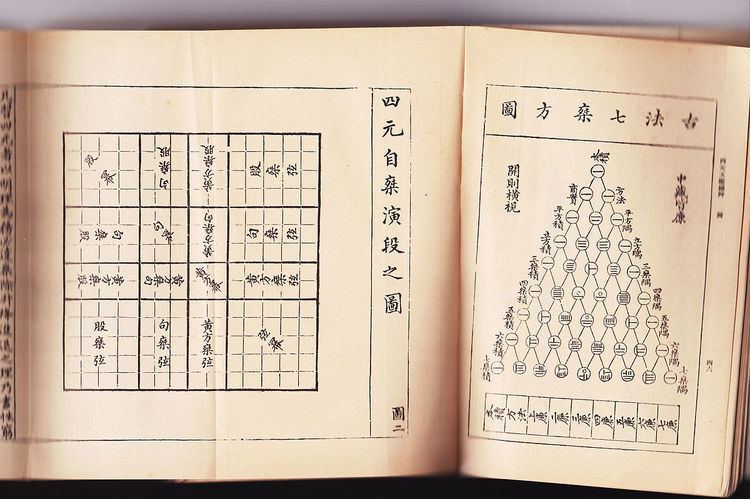 | ||
Jade Mirror of the Four Unknowns, Siyuan yujian (四元玉鉴), also referred to as Jade Mirror of the Four Origins, is a 1303 mathematical monograph by Yuan dynasty mathematician Zhu Shijie. With this masterpiece, Zhu brought Chinese algebra to its highest level.
Contents
- Introduction
- The Unitary Nebuls
- The Evolution of Three Talents
- Simultaneous of the Four Elements
- Problems of Right Angle Triangles and Rectangles
- Problems of Plane Figures
- Problems of Piece Goods
- Problems on Grain Storage
- Problems on Labour
- Problmes of Equations for Fractional Roots
- Surveying with Right Angle Triangles
- Summon Men According to Need
- Fruit pile
- Equation of Four Unknowns
- References
The book consists of an introduction and three books, with a total of 288 problems. The first four problems in the introduction illustrate his method of the four unknowns. He showed how to convert a problem stated verbally into a system of polynomial equations (up to the 14th order), by using up to four unknowns: 天Heaven, 地Earth, 人Man, 物Matter, and then how to reduce the system to a single polynomial equation in one unknown by successive elimination of unknowns. He then solved the high-order equation by Southern Song dynasty mathematician Qin Jiushao's "Ling long kai fang" method published in Shùshū Jiǔzhāng (“Mathematical Treatise in Nine Sections”) in 1247 (more than 570 years before English mathematician William Horner's method using synthetic division). To do this, he makes use of the Pascal triangle, which he labels as the diagram of an ancient method first discovered by Jia Xian before 1050.
Zhu also solved square and cube roots problems by solving quadratic and cubic equations, and added to the understanding of series and progressions, classifying them according to the coefficients of the Pascal triangle. He also showed how to solve systems of linear equations by reducing the matrix of their coefficients to diagonal form. His methods predate Blaise Pascal, William Horner, and modern matrix methods by many centuries. The preface of the book describes how Zhu travelled around China for 20 years as a teacher of mathematics.
Jade Mirror of the Four Unknowns consists of four books, with 24 classes and 288 problems, in which 232 problems deal with Tian yuan shu, 36 problems deal with variable of two variables, 13 problems of three variables, and 7 problems of four variables.
Introduction
The four quantities are x, y, z, w can be presented with the following diagram
The square of which is:
The Unitary Nebuls
This section deals with Tian yuan shu or problems of one unknown.
Question:Given the product of huangfan and zhi ji equals to 24 paces, and the sum of vertical and hypothenus equals to 9 paces, what is the value of the base ?Answer: 3 pacesSet up unitary tian as the base( that is let the base be the unknown quantity x)Since the product of huangfang and zhi ji = 24
in which
huangfan is defined as:
We obtain the following equation
Solve it and obtain x=3
equation:
from the given
equation:
we get:
and
by method of elimination, we obtain a quadratic equation
solution:
The Evolution of Three Talents
Template for solution of problem of three unknowns
Zhu Shijie explained the method of elimination in detail. His example has been quoted frequently in scientific literature。
Set up three equations as follows
Elimination of unknown between II and III
by manipulation of exchange of variables
We obtain
and
Elimination of unknown between IV and V we obtain a 3rd order equation
Solve to this 3rd order equation to obtain
Change back the variables
We obtain the hypothenus =5 paces
Simultaneous of the Four Elements
This section deals with simultaneous equations of four unknowns。
1: 0 0Successive elimination of unknowns to get
Solve this and obtain 14 paces
Problems of Right Angle Triangles and Rectangles
There are 18 problems in this section.
Problem 18
Obtain a tenth order polynomial equation:
The root of which is x = 3, multiply by 4, getting 12. That is the final answer。
Problems of Plane Figures
There are 18 problems in this section
Problems of Piece Goods
There are 9 problems in this section
Problems on Grain Storage
There are 6 problems in this section
Problems on Labour
There are 7 problems in this section
Problmes of Equations for Fractional Roots
There are 13 problems in this section
Surveying with Right Angle Triangles
There are eight problems in this section
Question:There is a rectangular town of unknown dimension which has one gate on each side。There is a pagoda located at 240 paces from the south gate.A man walking 180 paces from the west gate can see the pagoda, he then walks towards the south-east corner for 240 paces and reaches the pagoda, what is the length and width of the rectangular town ?
Answer: 120 paces in length and width one li
Let tian yuan unitary as half of the length, we obtain a 4th order equation
solve it and obtain x=240 paces,hence length =2x= 480 paces=1 li and 120paces。
Similarity, let tian yuan unitary(x) equals to half of width
we get the equation:
Solve it to obtain x=180 paces ,length =360 paces =one li。
Summon Men According to Need
Problem No 5 is the earliest 4th order interpolation formula in the world
men summoned :
In whicn
Fruit pile
This section contains 20 problems dealing with triangular piles, rectangular piles
Problem 1
Find the sum of triangular pile :
and value of the fruit pile is:
Zhu Shijie use Tian yuan shu to solve this problem by letting x=n
and obtained the formular:
From given condition
Solve it to obtain
Therefore,
Equation of Four Unknowns
Six problems of four unknowns。
Question 2
Yield a set of equations in four unknowns:.
